Recruitment Process
VerifiedAdded on 2023/01/11
|16
|4164
|54
AI Summary
Contribute Materials
Your contribution can guide someone’s learning journey. Share your
documents today.

RECRUITMENT
PROCESS
PROCESS
Secure Best Marks with AI Grader
Need help grading? Try our AI Grader for instant feedback on your assignments.
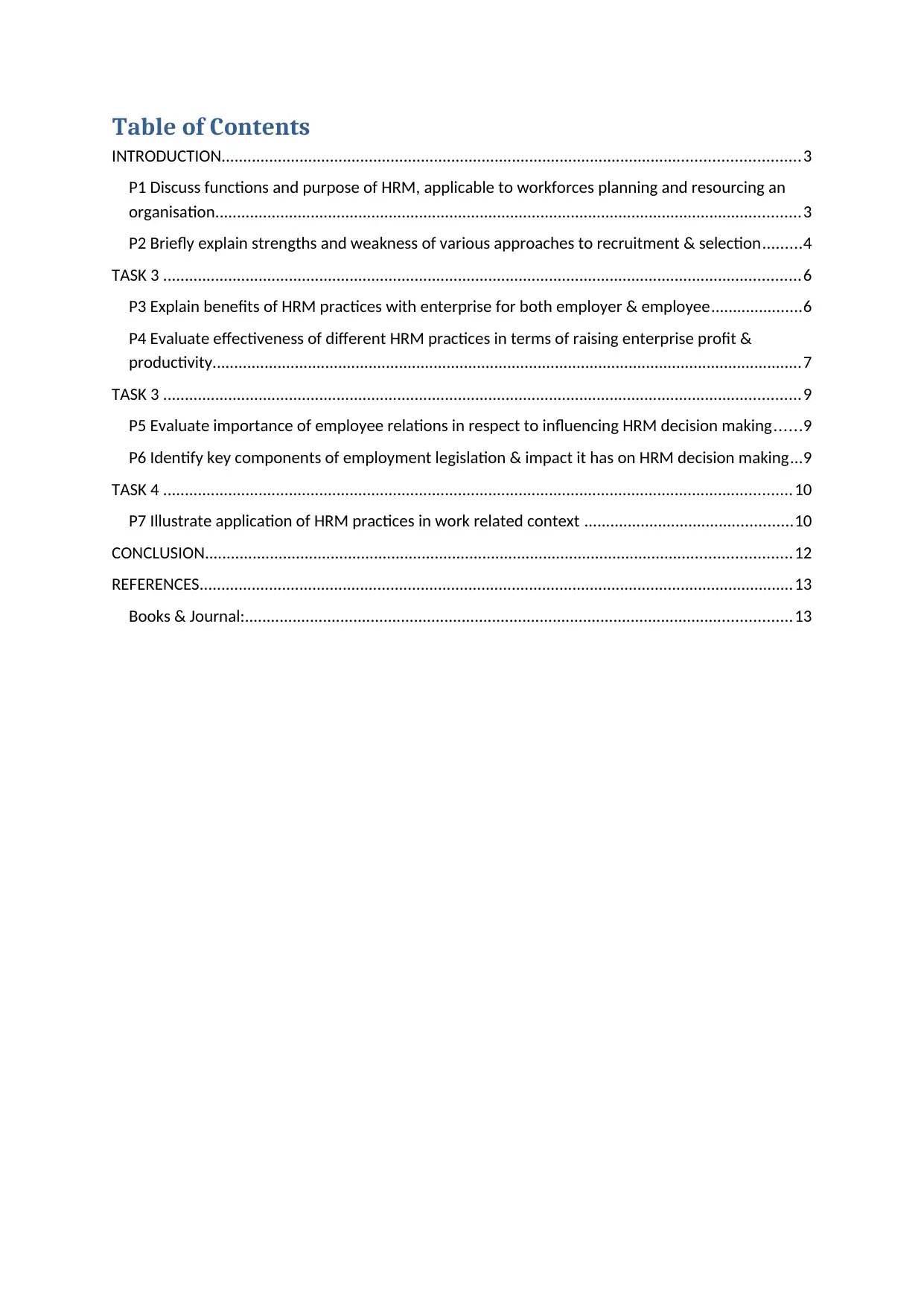
Table of Contents
INTRODUCTION.....................................................................................................................................3
P1 Discuss functions and purpose of HRM, applicable to workforces planning and resourcing an
organisation.......................................................................................................................................3
P2 Briefly explain strengths and weakness of various approaches to recruitment & selection.........4
TASK 3 ...................................................................................................................................................6
P3 Explain benefits of HRM practices with enterprise for both employer & employee.....................6
P4 Evaluate effectiveness of different HRM practices in terms of raising enterprise profit &
productivity........................................................................................................................................7
TASK 3 ...................................................................................................................................................9
P5 Evaluate importance of employee relations in respect to influencing HRM decision making......9
P6 Identify key components of employment legislation & impact it has on HRM decision making...9
TASK 4 .................................................................................................................................................10
P7 Illustrate application of HRM practices in work related context ................................................10
CONCLUSION.......................................................................................................................................12
REFERENCES.........................................................................................................................................13
Books & Journal:..............................................................................................................................13
INTRODUCTION.....................................................................................................................................3
P1 Discuss functions and purpose of HRM, applicable to workforces planning and resourcing an
organisation.......................................................................................................................................3
P2 Briefly explain strengths and weakness of various approaches to recruitment & selection.........4
TASK 3 ...................................................................................................................................................6
P3 Explain benefits of HRM practices with enterprise for both employer & employee.....................6
P4 Evaluate effectiveness of different HRM practices in terms of raising enterprise profit &
productivity........................................................................................................................................7
TASK 3 ...................................................................................................................................................9
P5 Evaluate importance of employee relations in respect to influencing HRM decision making......9
P6 Identify key components of employment legislation & impact it has on HRM decision making...9
TASK 4 .................................................................................................................................................10
P7 Illustrate application of HRM practices in work related context ................................................10
CONCLUSION.......................................................................................................................................12
REFERENCES.........................................................................................................................................13
Books & Journal:..............................................................................................................................13

INTRODUCTION
In this competitive era, market is expanding and new businesses are taking place in
the sector. Human Resource Planning is changing drastically over a period of time because
new ways and sources have been developed in this field. HRM is defined as process of
recruiting, selecting, training and development and appraising of employees within the
organisation. It is time consuming process but is adopted by enterprise to hire suitable
candidate for firm. Tesco, which is Multinational Corporation and is the largest supermarket
headquartered in UK. The brand has been dealing in variety of products such as groceries,
apparel & fashion etc. It has a well organised human resource department which helps
business to manage all the functions as well as operations smoothly. This report includes
functions of HRM, strength & weakness of process, human resource management practices &
its benefits, effectiveness of practices, importance of employee relations, key elements of
employment legislation and application of HR practices.
TASK 1
P1 Discuss functions and purpose of HRM, applicable to workforces planning and resourcing
an organisation
Human resource management is approach thorough which employee and employer
develop them-selves in proper manner. In an organisation, HR is hired so that all policies,
procedures, rules and regulations etc. are regulated as well as formulated appropriately. There
are many functions which are performed by human resource management which are
mentioned below-
Recruitment- It is a function in which human resource of company hires the ad
search for suitable candidate for the vacant roles in enterprise. It is done via many methods
such as internal and external. It depends upon the HR to select which type of approach. In
relation with Tesco, they use both type of methods because it becomes easy for human
resource department to pool candidates (Lussier, 2019).
Selection- Another function is selecting candidates which are most suitable for the roles and
job. It is also considered to be as negative process because of in this elimination is
done of pooled candidates & best one is selected for further process. It is crucial stage
because right & deserving are to be chosen so that they increase firm productivity
(Armstrong, 2020).
Training and development- Then comes the T& D function in which different
programmes or activities are being carried out to develop employee skills, knowledge and
capabilities. Through this, existing as well as new subordinates enhance their abilities at rapid
scale. Tesco conducts this function by giving difficult situations or task to their personnel so
that they are able to deal with them appropriately.
Purpose-
In this competitive era, market is expanding and new businesses are taking place in
the sector. Human Resource Planning is changing drastically over a period of time because
new ways and sources have been developed in this field. HRM is defined as process of
recruiting, selecting, training and development and appraising of employees within the
organisation. It is time consuming process but is adopted by enterprise to hire suitable
candidate for firm. Tesco, which is Multinational Corporation and is the largest supermarket
headquartered in UK. The brand has been dealing in variety of products such as groceries,
apparel & fashion etc. It has a well organised human resource department which helps
business to manage all the functions as well as operations smoothly. This report includes
functions of HRM, strength & weakness of process, human resource management practices &
its benefits, effectiveness of practices, importance of employee relations, key elements of
employment legislation and application of HR practices.
TASK 1
P1 Discuss functions and purpose of HRM, applicable to workforces planning and resourcing
an organisation
Human resource management is approach thorough which employee and employer
develop them-selves in proper manner. In an organisation, HR is hired so that all policies,
procedures, rules and regulations etc. are regulated as well as formulated appropriately. There
are many functions which are performed by human resource management which are
mentioned below-
Recruitment- It is a function in which human resource of company hires the ad
search for suitable candidate for the vacant roles in enterprise. It is done via many methods
such as internal and external. It depends upon the HR to select which type of approach. In
relation with Tesco, they use both type of methods because it becomes easy for human
resource department to pool candidates (Lussier, 2019).
Selection- Another function is selecting candidates which are most suitable for the roles and
job. It is also considered to be as negative process because of in this elimination is
done of pooled candidates & best one is selected for further process. It is crucial stage
because right & deserving are to be chosen so that they increase firm productivity
(Armstrong, 2020).
Training and development- Then comes the T& D function in which different
programmes or activities are being carried out to develop employee skills, knowledge and
capabilities. Through this, existing as well as new subordinates enhance their abilities at rapid
scale. Tesco conducts this function by giving difficult situations or task to their personnel so
that they are able to deal with them appropriately.
Purpose-

Organisation development- Main purpose of HRM is to develop organisation and
enhance their productivity by selecting as well as recruiting the right employee. Also, they
manage and maintain policies, procedures properly so that discipline is established in firm. It
is necessary to hire suitable candidates so that productivity, performance increases at larger
scale. Thus, Tesco select the applicants on the basis of personal interview & their academic
qualification.
Business environment- Another purpose is to establish positive environment in
management so that work is being carried out effectively. It is essential for every enterprise to
focus on peace at workplace so that stability of subordinates remains for longer period of
time. In relevance with chosen entity manager and HR make ensures that mutual relationship
is developed amongst the people so that conflicts and chances of errors do not arise.
So, from the above explained paragraph, it is analysed that human resource
management is wider concept which requires deep understanding of field. Moreover,
functions are purpose is needed to be stated so that it becomes easy to use them in
management appropriately (Joshua, 2019).
P2 Briefly explain strengths and weakness of various approaches to recruitment & selection
Recruitment and selection are main functions of HRM and which are to be carried out
properly. Recruitment refers to searching for candidates to apply for job in particular
organisation. Whereas selection is defined as screening or short listing of applicants for
vacant job role. Both have different types of approaches which are discussed below-
Recruitment methods
Approaches Strengths Weakness
Internal Recruitment Main strength of
internal recruitment is
that it is cheaper
method which is used
by firm for their
process (Wilton,
2016).
Another one is that it
is less times
consuming approach.
As it is internally
used it has limited
number of applicants
in selection process.
Also, in this
favouritism is done at
broader level because
referrals are used by
human resource.
In this, main strength While going through
enhance their productivity by selecting as well as recruiting the right employee. Also, they
manage and maintain policies, procedures properly so that discipline is established in firm. It
is necessary to hire suitable candidates so that productivity, performance increases at larger
scale. Thus, Tesco select the applicants on the basis of personal interview & their academic
qualification.
Business environment- Another purpose is to establish positive environment in
management so that work is being carried out effectively. It is essential for every enterprise to
focus on peace at workplace so that stability of subordinates remains for longer period of
time. In relevance with chosen entity manager and HR make ensures that mutual relationship
is developed amongst the people so that conflicts and chances of errors do not arise.
So, from the above explained paragraph, it is analysed that human resource
management is wider concept which requires deep understanding of field. Moreover,
functions are purpose is needed to be stated so that it becomes easy to use them in
management appropriately (Joshua, 2019).
P2 Briefly explain strengths and weakness of various approaches to recruitment & selection
Recruitment and selection are main functions of HRM and which are to be carried out
properly. Recruitment refers to searching for candidates to apply for job in particular
organisation. Whereas selection is defined as screening or short listing of applicants for
vacant job role. Both have different types of approaches which are discussed below-
Recruitment methods
Approaches Strengths Weakness
Internal Recruitment Main strength of
internal recruitment is
that it is cheaper
method which is used
by firm for their
process (Wilton,
2016).
Another one is that it
is less times
consuming approach.
As it is internally
used it has limited
number of applicants
in selection process.
Also, in this
favouritism is done at
broader level because
referrals are used by
human resource.
In this, main strength While going through
Secure Best Marks with AI Grader
Need help grading? Try our AI Grader for instant feedback on your assignments.
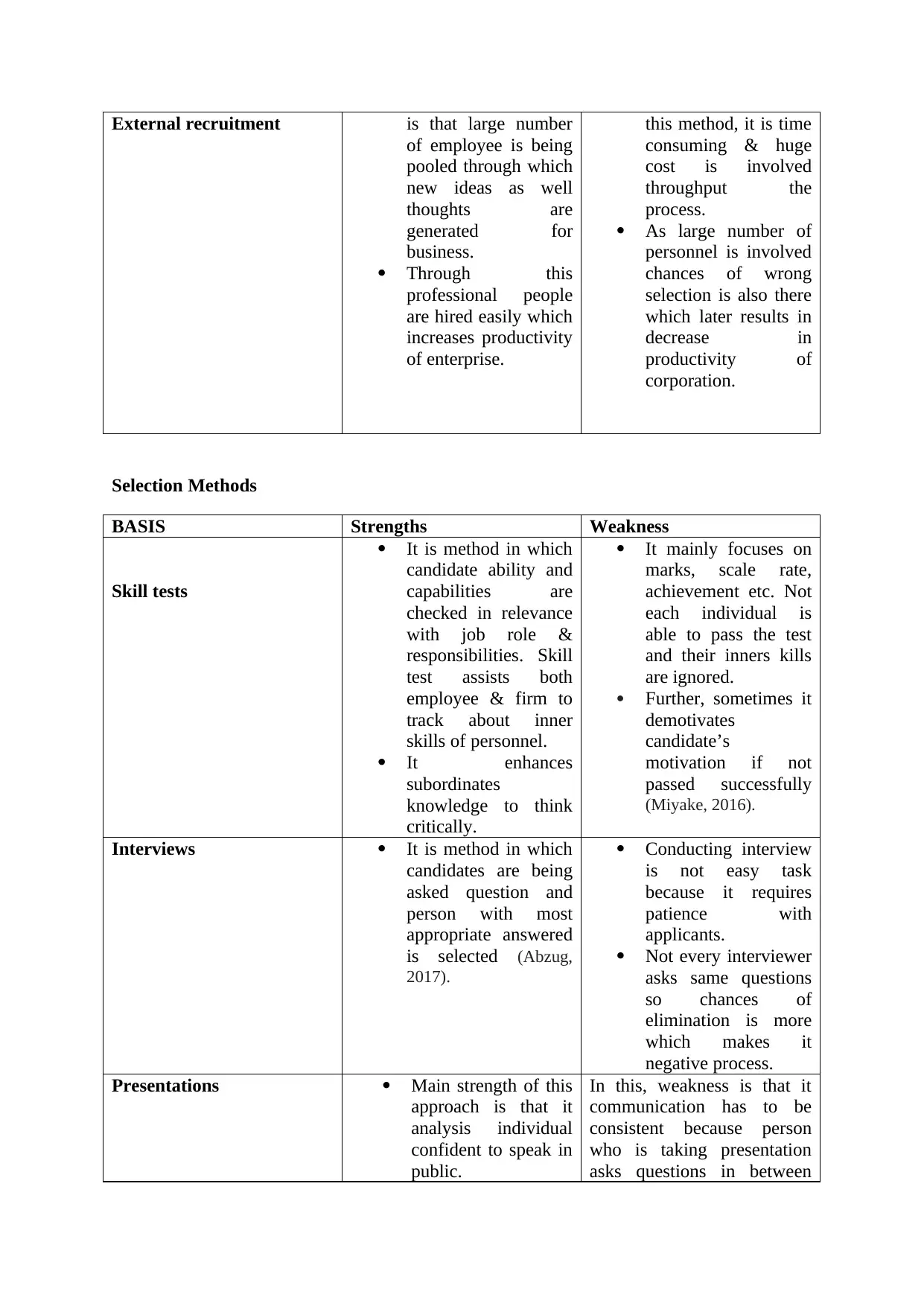
External recruitment is that large number
of employee is being
pooled through which
new ideas as well
thoughts are
generated for
business.
Through this
professional people
are hired easily which
increases productivity
of enterprise.
this method, it is time
consuming & huge
cost is involved
throughput the
process.
As large number of
personnel is involved
chances of wrong
selection is also there
which later results in
decrease in
productivity of
corporation.
Selection Methods
BASIS Strengths Weakness
Skill tests
It is method in which
candidate ability and
capabilities are
checked in relevance
with job role &
responsibilities. Skill
test assists both
employee & firm to
track about inner
skills of personnel.
It enhances
subordinates
knowledge to think
critically.
It mainly focuses on
marks, scale rate,
achievement etc. Not
each individual is
able to pass the test
and their inners kills
are ignored.
Further, sometimes it
demotivates
candidate’s
motivation if not
passed successfully
(Miyake, 2016).
Interviews It is method in which
candidates are being
asked question and
person with most
appropriate answered
is selected (Abzug,
2017).
Conducting interview
is not easy task
because it requires
patience with
applicants.
Not every interviewer
asks same questions
so chances of
elimination is more
which makes it
negative process.
Presentations Main strength of this
approach is that it
analysis individual
confident to speak in
public.
In this, weakness is that it
communication has to be
consistent because person
who is taking presentation
asks questions in between
of employee is being
pooled through which
new ideas as well
thoughts are
generated for
business.
Through this
professional people
are hired easily which
increases productivity
of enterprise.
this method, it is time
consuming & huge
cost is involved
throughput the
process.
As large number of
personnel is involved
chances of wrong
selection is also there
which later results in
decrease in
productivity of
corporation.
Selection Methods
BASIS Strengths Weakness
Skill tests
It is method in which
candidate ability and
capabilities are
checked in relevance
with job role &
responsibilities. Skill
test assists both
employee & firm to
track about inner
skills of personnel.
It enhances
subordinates
knowledge to think
critically.
It mainly focuses on
marks, scale rate,
achievement etc. Not
each individual is
able to pass the test
and their inners kills
are ignored.
Further, sometimes it
demotivates
candidate’s
motivation if not
passed successfully
(Miyake, 2016).
Interviews It is method in which
candidates are being
asked question and
person with most
appropriate answered
is selected (Abzug,
2017).
Conducting interview
is not easy task
because it requires
patience with
applicants.
Not every interviewer
asks same questions
so chances of
elimination is more
which makes it
negative process.
Presentations Main strength of this
approach is that it
analysis individual
confident to speak in
public.
In this, weakness is that it
communication has to be
consistent because person
who is taking presentation
asks questions in between
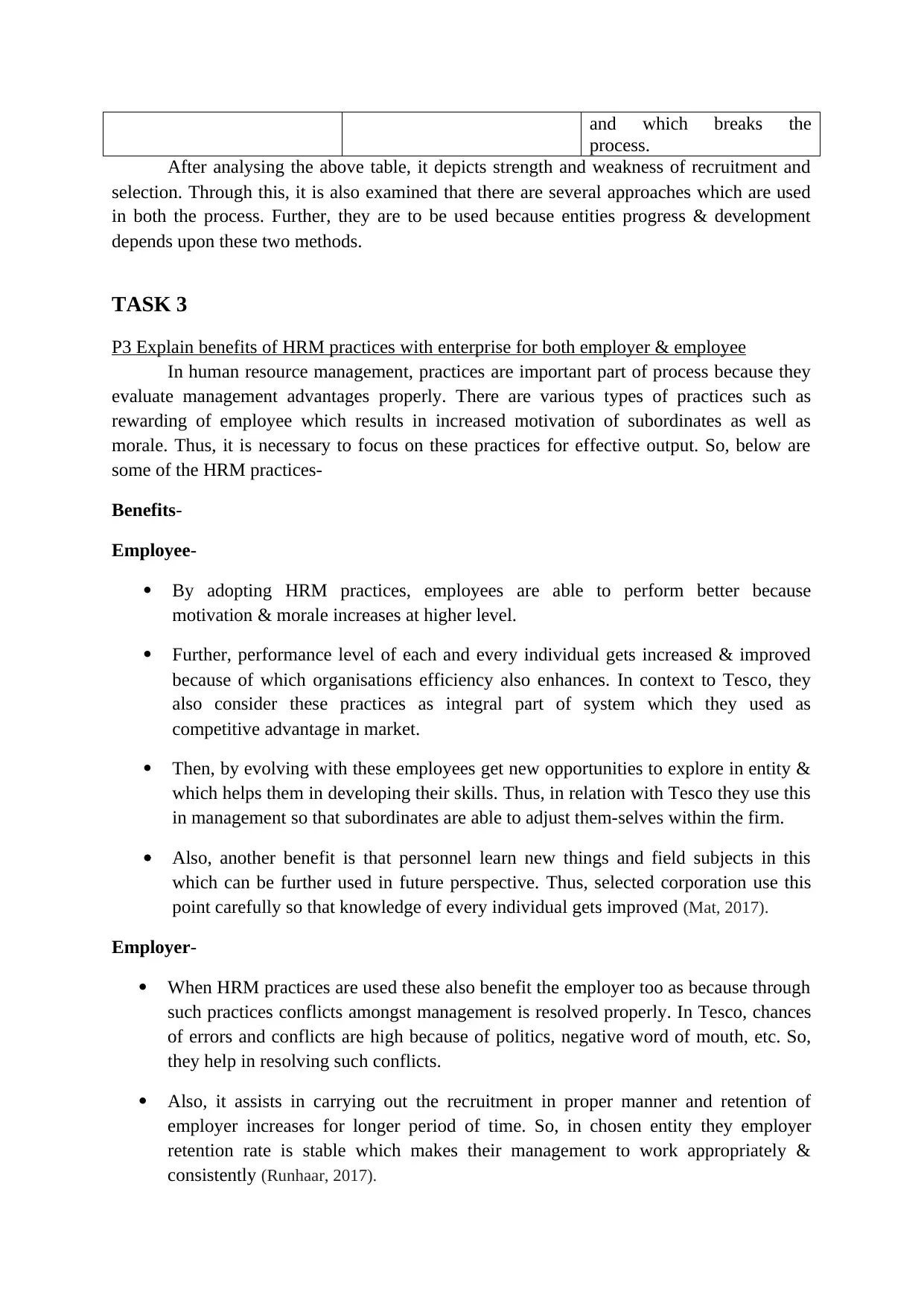
and which breaks the
process.
After analysing the above table, it depicts strength and weakness of recruitment and
selection. Through this, it is also examined that there are several approaches which are used
in both the process. Further, they are to be used because entities progress & development
depends upon these two methods.
TASK 3
P3 Explain benefits of HRM practices with enterprise for both employer & employee
In human resource management, practices are important part of process because they
evaluate management advantages properly. There are various types of practices such as
rewarding of employee which results in increased motivation of subordinates as well as
morale. Thus, it is necessary to focus on these practices for effective output. So, below are
some of the HRM practices-
Benefits-
Employee-
By adopting HRM practices, employees are able to perform better because
motivation & morale increases at higher level.
Further, performance level of each and every individual gets increased & improved
because of which organisations efficiency also enhances. In context to Tesco, they
also consider these practices as integral part of system which they used as
competitive advantage in market.
Then, by evolving with these employees get new opportunities to explore in entity &
which helps them in developing their skills. Thus, in relation with Tesco they use this
in management so that subordinates are able to adjust them-selves within the firm.
Also, another benefit is that personnel learn new things and field subjects in this
which can be further used in future perspective. Thus, selected corporation use this
point carefully so that knowledge of every individual gets improved (Mat, 2017).
Employer-
When HRM practices are used these also benefit the employer too as because through
such practices conflicts amongst management is resolved properly. In Tesco, chances
of errors and conflicts are high because of politics, negative word of mouth, etc. So,
they help in resolving such conflicts.
Also, it assists in carrying out the recruitment in proper manner and retention of
employer increases for longer period of time. So, in chosen entity they employer
retention rate is stable which makes their management to work appropriately &
consistently (Runhaar, 2017).
process.
After analysing the above table, it depicts strength and weakness of recruitment and
selection. Through this, it is also examined that there are several approaches which are used
in both the process. Further, they are to be used because entities progress & development
depends upon these two methods.
TASK 3
P3 Explain benefits of HRM practices with enterprise for both employer & employee
In human resource management, practices are important part of process because they
evaluate management advantages properly. There are various types of practices such as
rewarding of employee which results in increased motivation of subordinates as well as
morale. Thus, it is necessary to focus on these practices for effective output. So, below are
some of the HRM practices-
Benefits-
Employee-
By adopting HRM practices, employees are able to perform better because
motivation & morale increases at higher level.
Further, performance level of each and every individual gets increased & improved
because of which organisations efficiency also enhances. In context to Tesco, they
also consider these practices as integral part of system which they used as
competitive advantage in market.
Then, by evolving with these employees get new opportunities to explore in entity &
which helps them in developing their skills. Thus, in relation with Tesco they use this
in management so that subordinates are able to adjust them-selves within the firm.
Also, another benefit is that personnel learn new things and field subjects in this
which can be further used in future perspective. Thus, selected corporation use this
point carefully so that knowledge of every individual gets improved (Mat, 2017).
Employer-
When HRM practices are used these also benefit the employer too as because through
such practices conflicts amongst management is resolved properly. In Tesco, chances
of errors and conflicts are high because of politics, negative word of mouth, etc. So,
they help in resolving such conflicts.
Also, it assists in carrying out the recruitment in proper manner and retention of
employer increases for longer period of time. So, in chosen entity they employer
retention rate is stable which makes their management to work appropriately &
consistently (Runhaar, 2017).
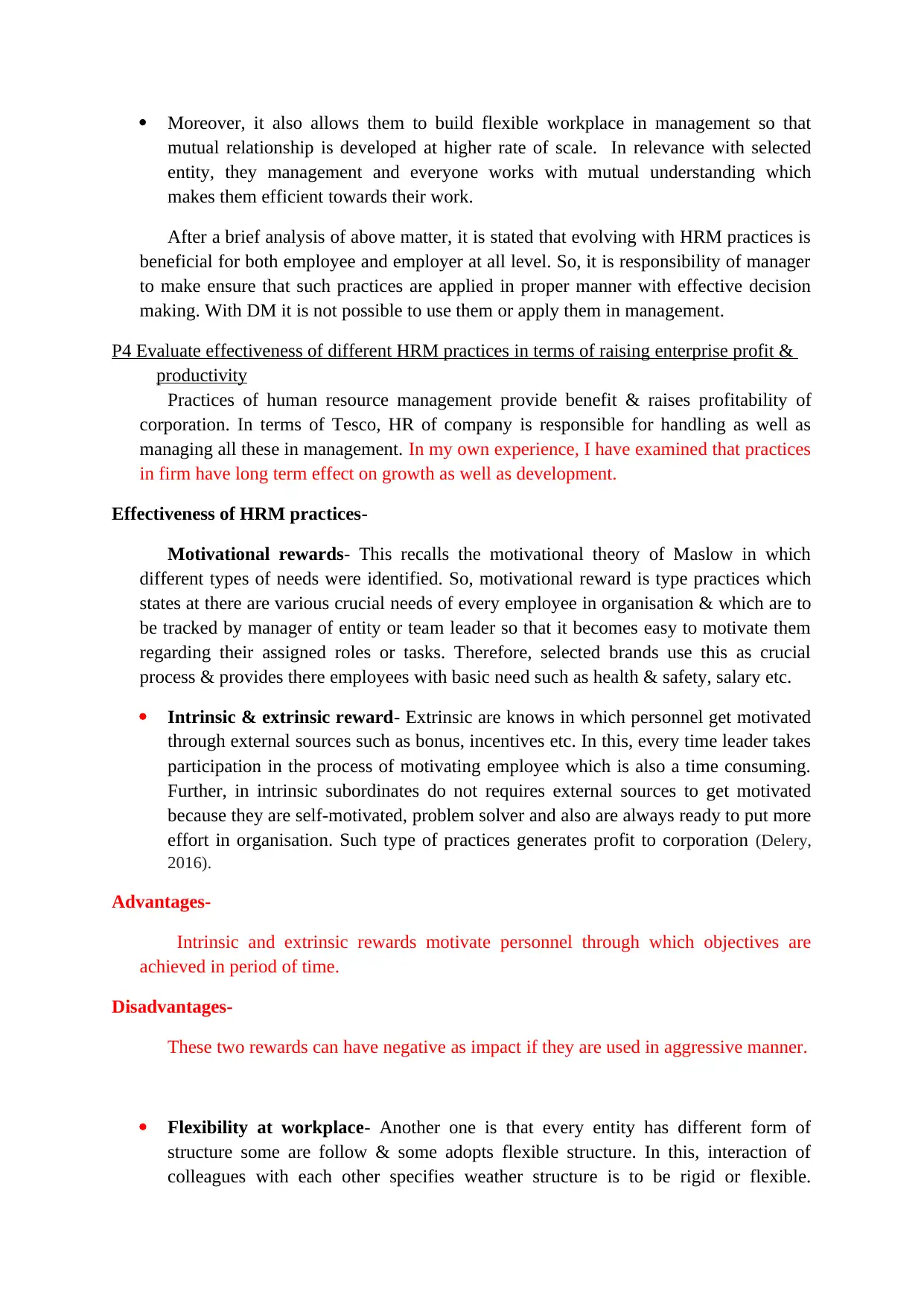
Moreover, it also allows them to build flexible workplace in management so that
mutual relationship is developed at higher rate of scale. In relevance with selected
entity, they management and everyone works with mutual understanding which
makes them efficient towards their work.
After a brief analysis of above matter, it is stated that evolving with HRM practices is
beneficial for both employee and employer at all level. So, it is responsibility of manager
to make ensure that such practices are applied in proper manner with effective decision
making. With DM it is not possible to use them or apply them in management.
P4 Evaluate effectiveness of different HRM practices in terms of raising enterprise profit &
productivity
Practices of human resource management provide benefit & raises profitability of
corporation. In terms of Tesco, HR of company is responsible for handling as well as
managing all these in management. In my own experience, I have examined that practices
in firm have long term effect on growth as well as development.
Effectiveness of HRM practices-
Motivational rewards- This recalls the motivational theory of Maslow in which
different types of needs were identified. So, motivational reward is type practices which
states at there are various crucial needs of every employee in organisation & which are to
be tracked by manager of entity or team leader so that it becomes easy to motivate them
regarding their assigned roles or tasks. Therefore, selected brands use this as crucial
process & provides there employees with basic need such as health & safety, salary etc.
Intrinsic & extrinsic reward- Extrinsic are knows in which personnel get motivated
through external sources such as bonus, incentives etc. In this, every time leader takes
participation in the process of motivating employee which is also a time consuming.
Further, in intrinsic subordinates do not requires external sources to get motivated
because they are self-motivated, problem solver and also are always ready to put more
effort in organisation. Such type of practices generates profit to corporation (Delery,
2016).
Advantages-
Intrinsic and extrinsic rewards motivate personnel through which objectives are
achieved in period of time.
Disadvantages-
These two rewards can have negative as impact if they are used in aggressive manner.
Flexibility at workplace- Another one is that every entity has different form of
structure some are follow & some adopts flexible structure. In this, interaction of
colleagues with each other specifies weather structure is to be rigid or flexible.
mutual relationship is developed at higher rate of scale. In relevance with selected
entity, they management and everyone works with mutual understanding which
makes them efficient towards their work.
After a brief analysis of above matter, it is stated that evolving with HRM practices is
beneficial for both employee and employer at all level. So, it is responsibility of manager
to make ensure that such practices are applied in proper manner with effective decision
making. With DM it is not possible to use them or apply them in management.
P4 Evaluate effectiveness of different HRM practices in terms of raising enterprise profit &
productivity
Practices of human resource management provide benefit & raises profitability of
corporation. In terms of Tesco, HR of company is responsible for handling as well as
managing all these in management. In my own experience, I have examined that practices
in firm have long term effect on growth as well as development.
Effectiveness of HRM practices-
Motivational rewards- This recalls the motivational theory of Maslow in which
different types of needs were identified. So, motivational reward is type practices which
states at there are various crucial needs of every employee in organisation & which are to
be tracked by manager of entity or team leader so that it becomes easy to motivate them
regarding their assigned roles or tasks. Therefore, selected brands use this as crucial
process & provides there employees with basic need such as health & safety, salary etc.
Intrinsic & extrinsic reward- Extrinsic are knows in which personnel get motivated
through external sources such as bonus, incentives etc. In this, every time leader takes
participation in the process of motivating employee which is also a time consuming.
Further, in intrinsic subordinates do not requires external sources to get motivated
because they are self-motivated, problem solver and also are always ready to put more
effort in organisation. Such type of practices generates profit to corporation (Delery,
2016).
Advantages-
Intrinsic and extrinsic rewards motivate personnel through which objectives are
achieved in period of time.
Disadvantages-
These two rewards can have negative as impact if they are used in aggressive manner.
Flexibility at workplace- Another one is that every entity has different form of
structure some are follow & some adopts flexible structure. In this, interaction of
colleagues with each other specifies weather structure is to be rigid or flexible.
Paraphrase This Document
Need a fresh take? Get an instant paraphrase of this document with our AI Paraphraser
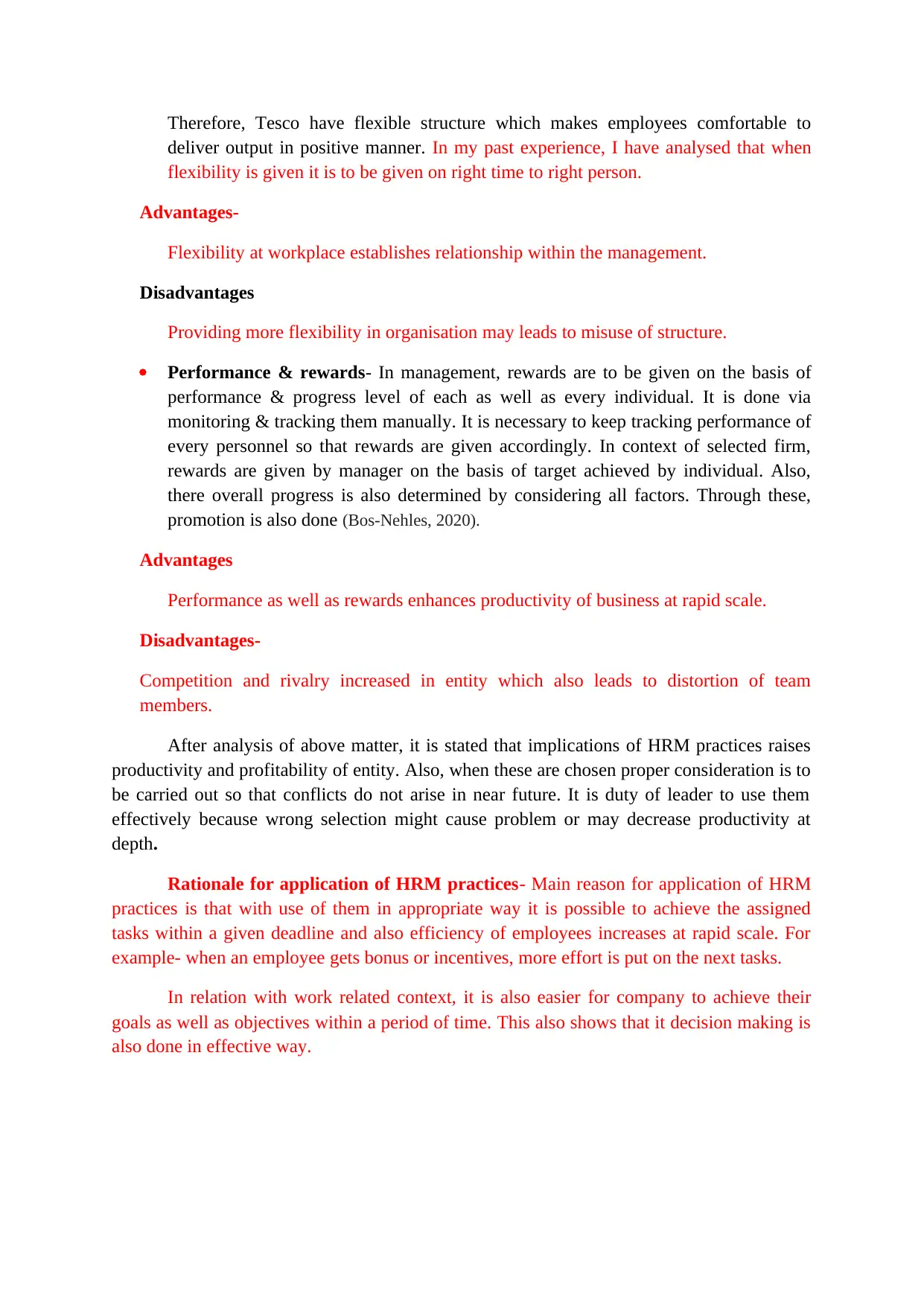
Therefore, Tesco have flexible structure which makes employees comfortable to
deliver output in positive manner. In my past experience, I have analysed that when
flexibility is given it is to be given on right time to right person.
Advantages-
Flexibility at workplace establishes relationship within the management.
Disadvantages
Providing more flexibility in organisation may leads to misuse of structure.
Performance & rewards- In management, rewards are to be given on the basis of
performance & progress level of each as well as every individual. It is done via
monitoring & tracking them manually. It is necessary to keep tracking performance of
every personnel so that rewards are given accordingly. In context of selected firm,
rewards are given by manager on the basis of target achieved by individual. Also,
there overall progress is also determined by considering all factors. Through these,
promotion is also done (Bos-Nehles, 2020).
Advantages
Performance as well as rewards enhances productivity of business at rapid scale.
Disadvantages-
Competition and rivalry increased in entity which also leads to distortion of team
members.
After analysis of above matter, it is stated that implications of HRM practices raises
productivity and profitability of entity. Also, when these are chosen proper consideration is to
be carried out so that conflicts do not arise in near future. It is duty of leader to use them
effectively because wrong selection might cause problem or may decrease productivity at
depth.
Rationale for application of HRM practices- Main reason for application of HRM
practices is that with use of them in appropriate way it is possible to achieve the assigned
tasks within a given deadline and also efficiency of employees increases at rapid scale. For
example- when an employee gets bonus or incentives, more effort is put on the next tasks.
In relation with work related context, it is also easier for company to achieve their
goals as well as objectives within a period of time. This also shows that it decision making is
also done in effective way.
deliver output in positive manner. In my past experience, I have analysed that when
flexibility is given it is to be given on right time to right person.
Advantages-
Flexibility at workplace establishes relationship within the management.
Disadvantages
Providing more flexibility in organisation may leads to misuse of structure.
Performance & rewards- In management, rewards are to be given on the basis of
performance & progress level of each as well as every individual. It is done via
monitoring & tracking them manually. It is necessary to keep tracking performance of
every personnel so that rewards are given accordingly. In context of selected firm,
rewards are given by manager on the basis of target achieved by individual. Also,
there overall progress is also determined by considering all factors. Through these,
promotion is also done (Bos-Nehles, 2020).
Advantages
Performance as well as rewards enhances productivity of business at rapid scale.
Disadvantages-
Competition and rivalry increased in entity which also leads to distortion of team
members.
After analysis of above matter, it is stated that implications of HRM practices raises
productivity and profitability of entity. Also, when these are chosen proper consideration is to
be carried out so that conflicts do not arise in near future. It is duty of leader to use them
effectively because wrong selection might cause problem or may decrease productivity at
depth.
Rationale for application of HRM practices- Main reason for application of HRM
practices is that with use of them in appropriate way it is possible to achieve the assigned
tasks within a given deadline and also efficiency of employees increases at rapid scale. For
example- when an employee gets bonus or incentives, more effort is put on the next tasks.
In relation with work related context, it is also easier for company to achieve their
goals as well as objectives within a period of time. This also shows that it decision making is
also done in effective way.
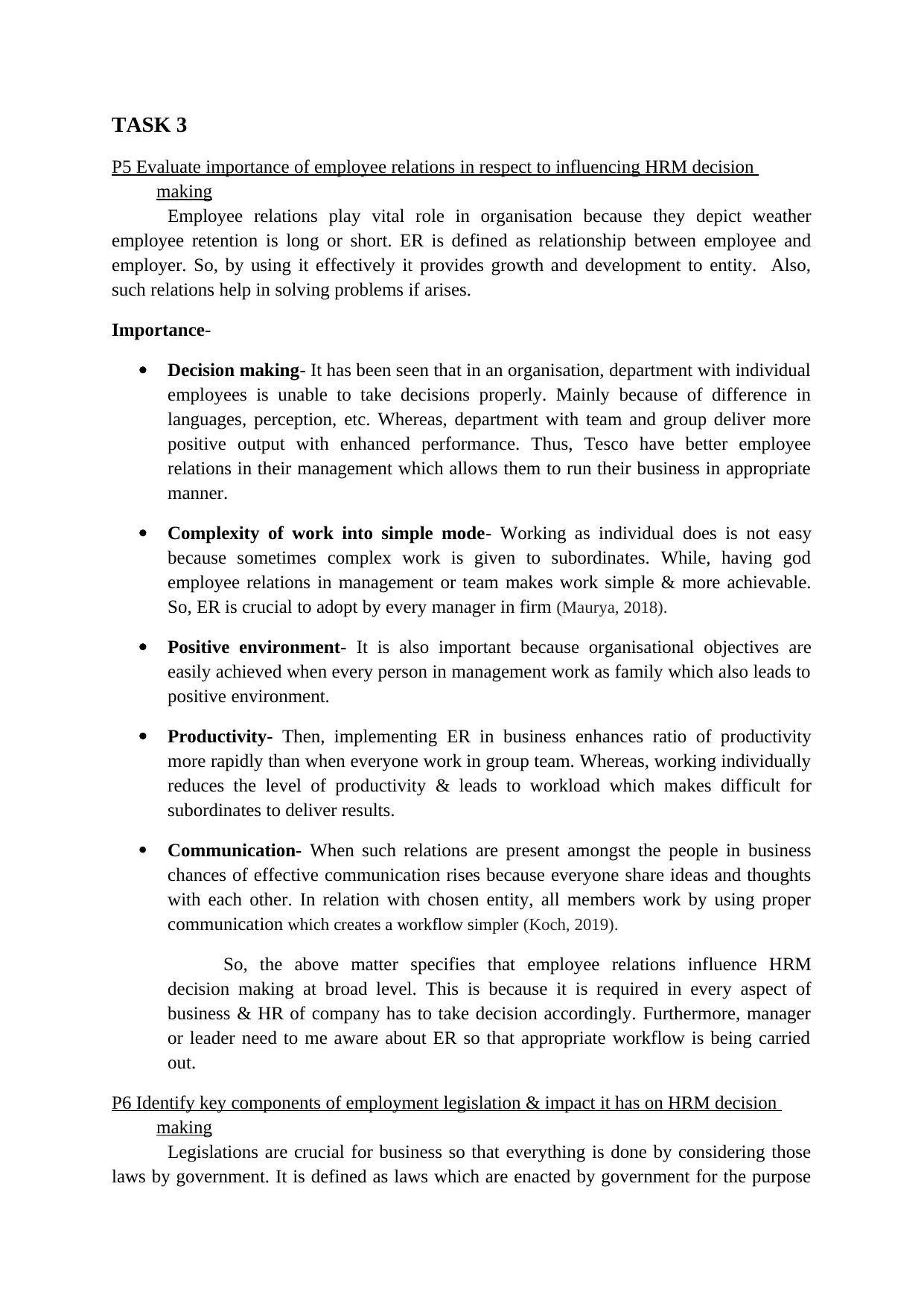
TASK 3
P5 Evaluate importance of employee relations in respect to influencing HRM decision
making
Employee relations play vital role in organisation because they depict weather
employee retention is long or short. ER is defined as relationship between employee and
employer. So, by using it effectively it provides growth and development to entity. Also,
such relations help in solving problems if arises.
Importance-
Decision making- It has been seen that in an organisation, department with individual
employees is unable to take decisions properly. Mainly because of difference in
languages, perception, etc. Whereas, department with team and group deliver more
positive output with enhanced performance. Thus, Tesco have better employee
relations in their management which allows them to run their business in appropriate
manner.
Complexity of work into simple mode- Working as individual does is not easy
because sometimes complex work is given to subordinates. While, having god
employee relations in management or team makes work simple & more achievable.
So, ER is crucial to adopt by every manager in firm (Maurya, 2018).
Positive environment- It is also important because organisational objectives are
easily achieved when every person in management work as family which also leads to
positive environment.
Productivity- Then, implementing ER in business enhances ratio of productivity
more rapidly than when everyone work in group team. Whereas, working individually
reduces the level of productivity & leads to workload which makes difficult for
subordinates to deliver results.
Communication- When such relations are present amongst the people in business
chances of effective communication rises because everyone share ideas and thoughts
with each other. In relation with chosen entity, all members work by using proper
communication which creates a workflow simpler (Koch, 2019).
So, the above matter specifies that employee relations influence HRM
decision making at broad level. This is because it is required in every aspect of
business & HR of company has to take decision accordingly. Furthermore, manager
or leader need to me aware about ER so that appropriate workflow is being carried
out.
P6 Identify key components of employment legislation & impact it has on HRM decision
making
Legislations are crucial for business so that everything is done by considering those
laws by government. It is defined as laws which are enacted by government for the purpose
P5 Evaluate importance of employee relations in respect to influencing HRM decision
making
Employee relations play vital role in organisation because they depict weather
employee retention is long or short. ER is defined as relationship between employee and
employer. So, by using it effectively it provides growth and development to entity. Also,
such relations help in solving problems if arises.
Importance-
Decision making- It has been seen that in an organisation, department with individual
employees is unable to take decisions properly. Mainly because of difference in
languages, perception, etc. Whereas, department with team and group deliver more
positive output with enhanced performance. Thus, Tesco have better employee
relations in their management which allows them to run their business in appropriate
manner.
Complexity of work into simple mode- Working as individual does is not easy
because sometimes complex work is given to subordinates. While, having god
employee relations in management or team makes work simple & more achievable.
So, ER is crucial to adopt by every manager in firm (Maurya, 2018).
Positive environment- It is also important because organisational objectives are
easily achieved when every person in management work as family which also leads to
positive environment.
Productivity- Then, implementing ER in business enhances ratio of productivity
more rapidly than when everyone work in group team. Whereas, working individually
reduces the level of productivity & leads to workload which makes difficult for
subordinates to deliver results.
Communication- When such relations are present amongst the people in business
chances of effective communication rises because everyone share ideas and thoughts
with each other. In relation with chosen entity, all members work by using proper
communication which creates a workflow simpler (Koch, 2019).
So, the above matter specifies that employee relations influence HRM
decision making at broad level. This is because it is required in every aspect of
business & HR of company has to take decision accordingly. Furthermore, manager
or leader need to me aware about ER so that appropriate workflow is being carried
out.
P6 Identify key components of employment legislation & impact it has on HRM decision
making
Legislations are crucial for business so that everything is done by considering those
laws by government. It is defined as laws which are enacted by government for the purpose
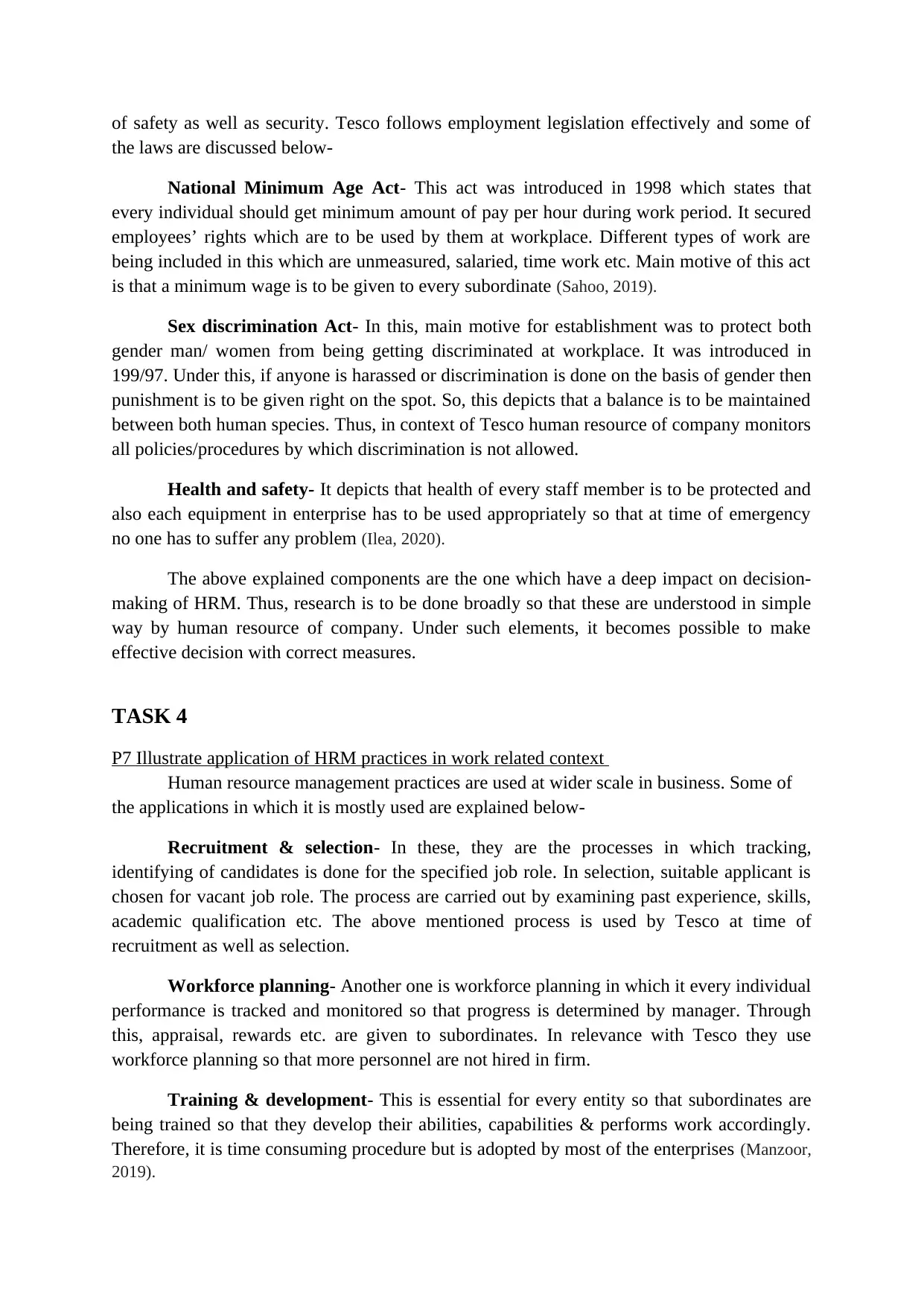
of safety as well as security. Tesco follows employment legislation effectively and some of
the laws are discussed below-
National Minimum Age Act- This act was introduced in 1998 which states that
every individual should get minimum amount of pay per hour during work period. It secured
employees’ rights which are to be used by them at workplace. Different types of work are
being included in this which are unmeasured, salaried, time work etc. Main motive of this act
is that a minimum wage is to be given to every subordinate (Sahoo, 2019).
Sex discrimination Act- In this, main motive for establishment was to protect both
gender man/ women from being getting discriminated at workplace. It was introduced in
199/97. Under this, if anyone is harassed or discrimination is done on the basis of gender then
punishment is to be given right on the spot. So, this depicts that a balance is to be maintained
between both human species. Thus, in context of Tesco human resource of company monitors
all policies/procedures by which discrimination is not allowed.
Health and safety- It depicts that health of every staff member is to be protected and
also each equipment in enterprise has to be used appropriately so that at time of emergency
no one has to suffer any problem (Ilea, 2020).
The above explained components are the one which have a deep impact on decision-
making of HRM. Thus, research is to be done broadly so that these are understood in simple
way by human resource of company. Under such elements, it becomes possible to make
effective decision with correct measures.
TASK 4
P7 Illustrate application of HRM practices in work related context
Human resource management practices are used at wider scale in business. Some of
the applications in which it is mostly used are explained below-
Recruitment & selection- In these, they are the processes in which tracking,
identifying of candidates is done for the specified job role. In selection, suitable applicant is
chosen for vacant job role. The process are carried out by examining past experience, skills,
academic qualification etc. The above mentioned process is used by Tesco at time of
recruitment as well as selection.
Workforce planning- Another one is workforce planning in which it every individual
performance is tracked and monitored so that progress is determined by manager. Through
this, appraisal, rewards etc. are given to subordinates. In relevance with Tesco they use
workforce planning so that more personnel are not hired in firm.
Training & development- This is essential for every entity so that subordinates are
being trained so that they develop their abilities, capabilities & performs work accordingly.
Therefore, it is time consuming procedure but is adopted by most of the enterprises (Manzoor,
2019).
the laws are discussed below-
National Minimum Age Act- This act was introduced in 1998 which states that
every individual should get minimum amount of pay per hour during work period. It secured
employees’ rights which are to be used by them at workplace. Different types of work are
being included in this which are unmeasured, salaried, time work etc. Main motive of this act
is that a minimum wage is to be given to every subordinate (Sahoo, 2019).
Sex discrimination Act- In this, main motive for establishment was to protect both
gender man/ women from being getting discriminated at workplace. It was introduced in
199/97. Under this, if anyone is harassed or discrimination is done on the basis of gender then
punishment is to be given right on the spot. So, this depicts that a balance is to be maintained
between both human species. Thus, in context of Tesco human resource of company monitors
all policies/procedures by which discrimination is not allowed.
Health and safety- It depicts that health of every staff member is to be protected and
also each equipment in enterprise has to be used appropriately so that at time of emergency
no one has to suffer any problem (Ilea, 2020).
The above explained components are the one which have a deep impact on decision-
making of HRM. Thus, research is to be done broadly so that these are understood in simple
way by human resource of company. Under such elements, it becomes possible to make
effective decision with correct measures.
TASK 4
P7 Illustrate application of HRM practices in work related context
Human resource management practices are used at wider scale in business. Some of
the applications in which it is mostly used are explained below-
Recruitment & selection- In these, they are the processes in which tracking,
identifying of candidates is done for the specified job role. In selection, suitable applicant is
chosen for vacant job role. The process are carried out by examining past experience, skills,
academic qualification etc. The above mentioned process is used by Tesco at time of
recruitment as well as selection.
Workforce planning- Another one is workforce planning in which it every individual
performance is tracked and monitored so that progress is determined by manager. Through
this, appraisal, rewards etc. are given to subordinates. In relevance with Tesco they use
workforce planning so that more personnel are not hired in firm.
Training & development- This is essential for every entity so that subordinates are
being trained so that they develop their abilities, capabilities & performs work accordingly.
Therefore, it is time consuming procedure but is adopted by most of the enterprises (Manzoor,
2019).
Secure Best Marks with AI Grader
Need help grading? Try our AI Grader for instant feedback on your assignments.
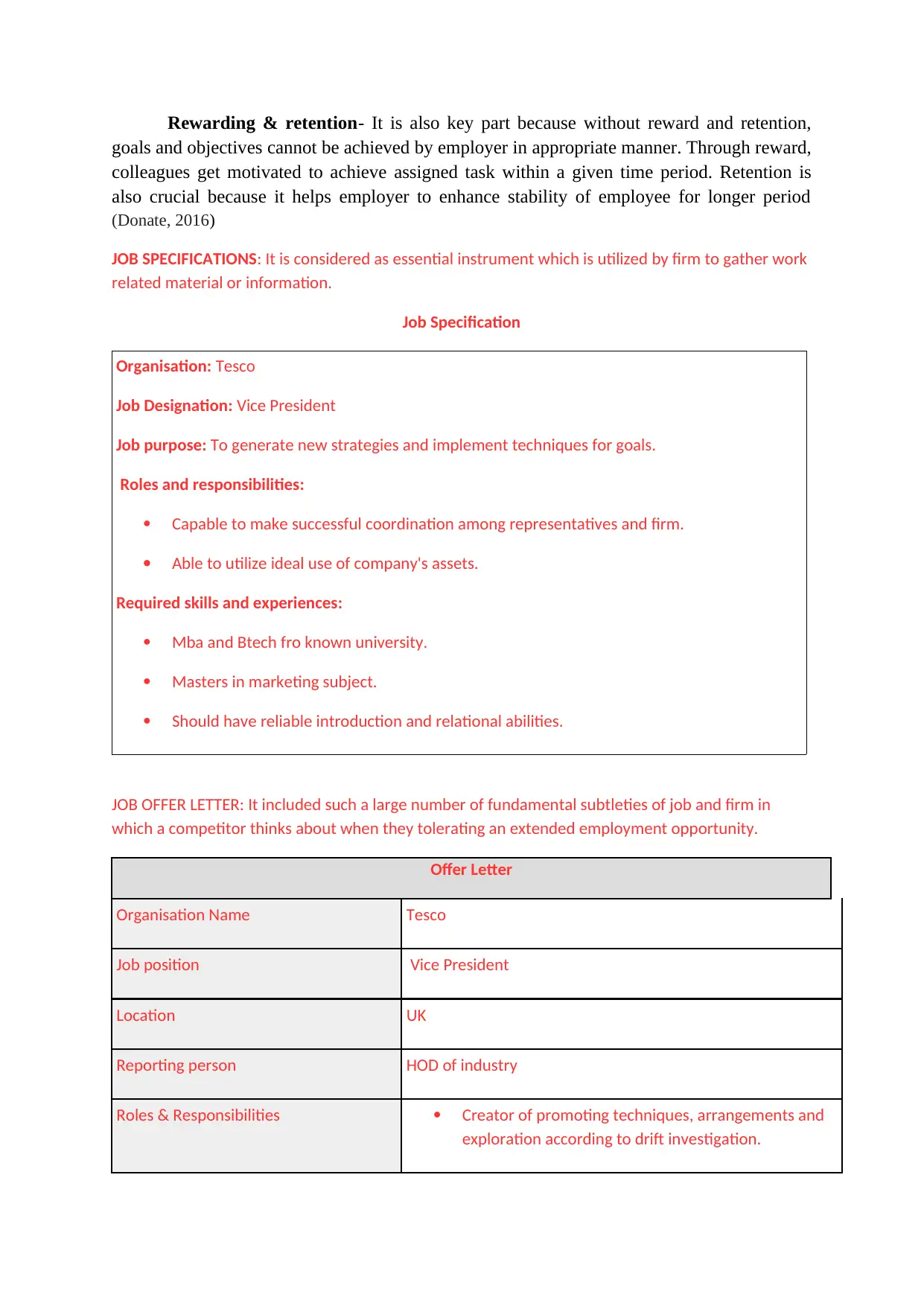
Rewarding & retention- It is also key part because without reward and retention,
goals and objectives cannot be achieved by employer in appropriate manner. Through reward,
colleagues get motivated to achieve assigned task within a given time period. Retention is
also crucial because it helps employer to enhance stability of employee for longer period
(Donate, 2016)
JOB SPECIFICATIONS: It is considered as essential instrument which is utilized by firm to gather work
related material or information.
Job Specification
Organisation: Tesco
Job Designation: Vice President
Job purpose: To generate new strategies and implement techniques for goals.
Roles and responsibilities:
Capable to make successful coordination among representatives and firm.
Able to utilize ideal use of company's assets.
Required skills and experiences:
Mba and Btech fro known university.
Masters in marketing subject.
Should have reliable introduction and relational abilities.
JOB OFFER LETTER: It included such a large number of fundamental subtleties of job and firm in
which a competitor thinks about when they tolerating an extended employment opportunity.
Offer Letter
Organisation Name Tesco
Job position Vice President
Location UK
Reporting person HOD of industry
Roles & Responsibilities Creator of promoting techniques, arrangements and
exploration according to drift investigation.
goals and objectives cannot be achieved by employer in appropriate manner. Through reward,
colleagues get motivated to achieve assigned task within a given time period. Retention is
also crucial because it helps employer to enhance stability of employee for longer period
(Donate, 2016)
JOB SPECIFICATIONS: It is considered as essential instrument which is utilized by firm to gather work
related material or information.
Job Specification
Organisation: Tesco
Job Designation: Vice President
Job purpose: To generate new strategies and implement techniques for goals.
Roles and responsibilities:
Capable to make successful coordination among representatives and firm.
Able to utilize ideal use of company's assets.
Required skills and experiences:
Mba and Btech fro known university.
Masters in marketing subject.
Should have reliable introduction and relational abilities.
JOB OFFER LETTER: It included such a large number of fundamental subtleties of job and firm in
which a competitor thinks about when they tolerating an extended employment opportunity.
Offer Letter
Organisation Name Tesco
Job position Vice President
Location UK
Reporting person HOD of industry
Roles & Responsibilities Creator of promoting techniques, arrangements and
exploration according to drift investigation.

Recognize entire interest of shoppers
Working Duration 9.30 am to 5:00 pm
Accommodations for employees Sound condition of work with positive culture that expansion
their working execution in firm so representatives can
accomplish its focused on objectives.
After examining above matter, it is analysed that applications of HRM are at larger
scale. So, with help of research and knowledge these can be used positively as well as
effectively.
Working Duration 9.30 am to 5:00 pm
Accommodations for employees Sound condition of work with positive culture that expansion
their working execution in firm so representatives can
accomplish its focused on objectives.
After examining above matter, it is analysed that applications of HRM are at larger
scale. So, with help of research and knowledge these can be used positively as well as
effectively.
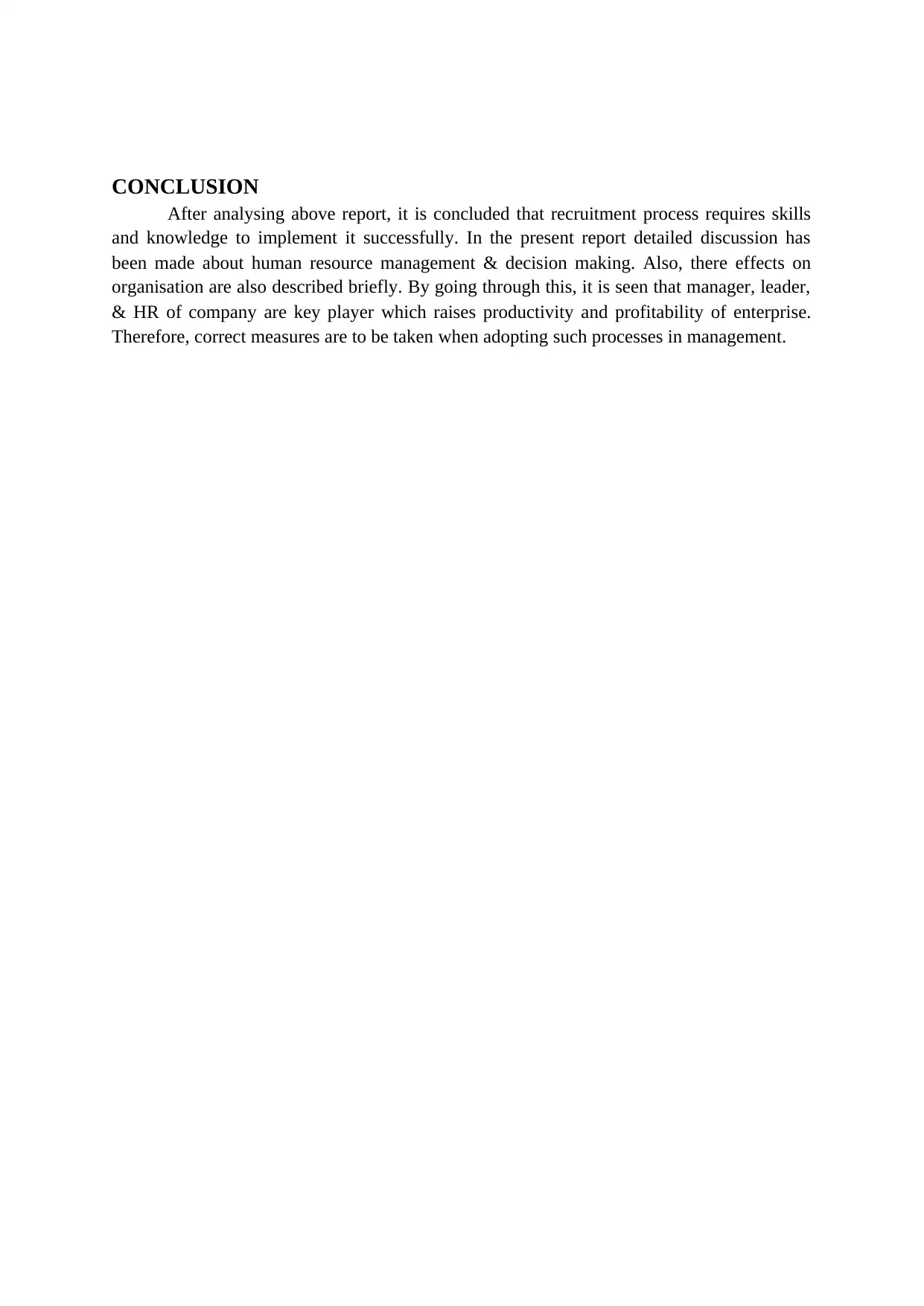
CONCLUSION
After analysing above report, it is concluded that recruitment process requires skills
and knowledge to implement it successfully. In the present report detailed discussion has
been made about human resource management & decision making. Also, there effects on
organisation are also described briefly. By going through this, it is seen that manager, leader,
& HR of company are key player which raises productivity and profitability of enterprise.
Therefore, correct measures are to be taken when adopting such processes in management.
After analysing above report, it is concluded that recruitment process requires skills
and knowledge to implement it successfully. In the present report detailed discussion has
been made about human resource management & decision making. Also, there effects on
organisation are also described briefly. By going through this, it is seen that manager, leader,
& HR of company are key player which raises productivity and profitability of enterprise.
Therefore, correct measures are to be taken when adopting such processes in management.
Paraphrase This Document
Need a fresh take? Get an instant paraphrase of this document with our AI Paraphraser
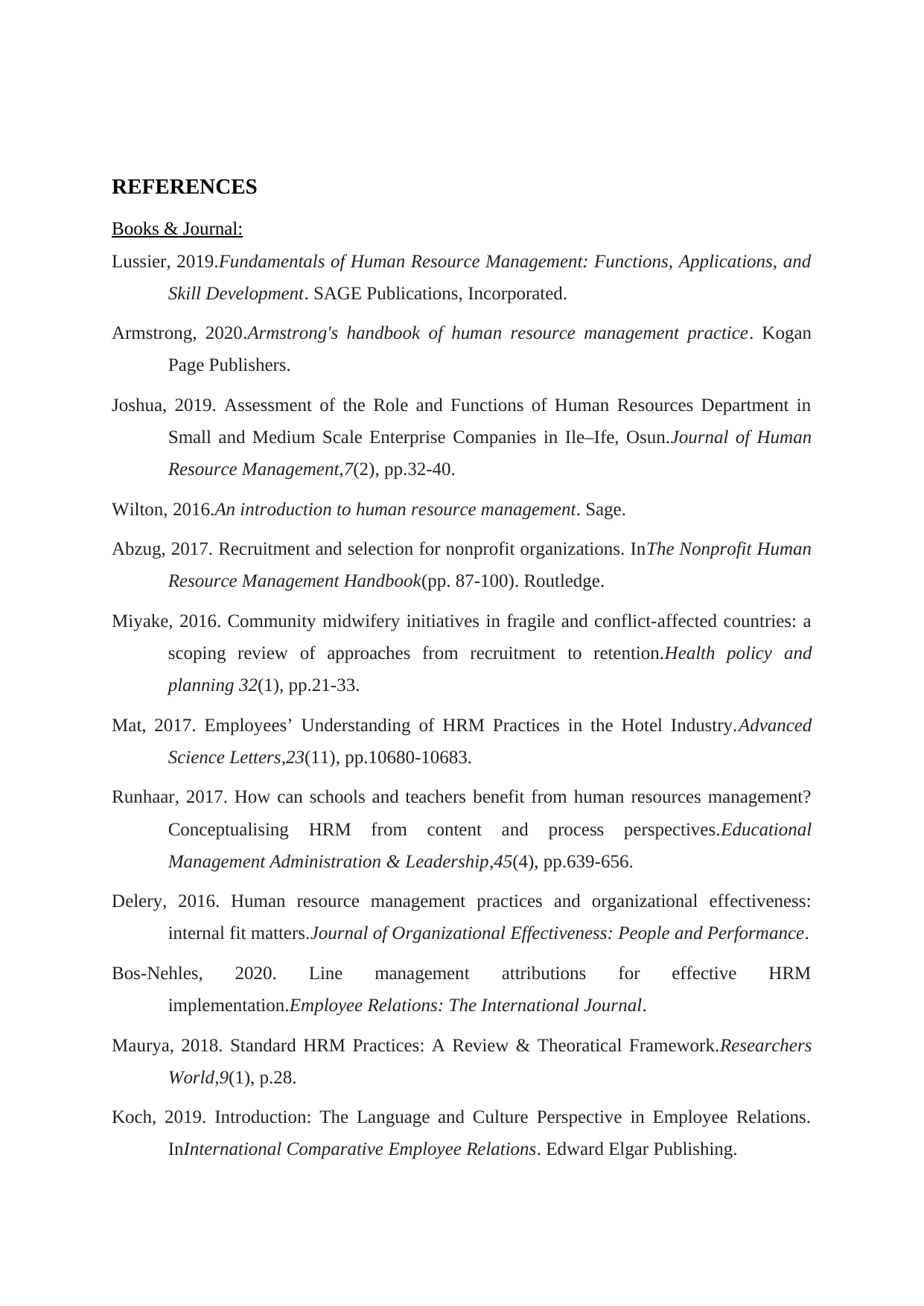
REFERENCES
Books & Journal:
Lussier, 2019.Fundamentals of Human Resource Management: Functions, Applications, and
Skill Development. SAGE Publications, Incorporated.
Armstrong, 2020.Armstrong's handbook of human resource management practice. Kogan
Page Publishers.
Joshua, 2019. Assessment of the Role and Functions of Human Resources Department in
Small and Medium Scale Enterprise Companies in Ile–Ife, Osun.Journal of Human
Resource Management,7(2), pp.32-40.
Wilton, 2016.An introduction to human resource management. Sage.
Abzug, 2017. Recruitment and selection for nonprofit organizations. InThe Nonprofit Human
Resource Management Handbook(pp. 87-100). Routledge.
Miyake, 2016. Community midwifery initiatives in fragile and conflict-affected countries: a
scoping review of approaches from recruitment to retention.Health policy and
planning 32(1), pp.21-33.
Mat, 2017. Employees’ Understanding of HRM Practices in the Hotel Industry.Advanced
Science Letters,23(11), pp.10680-10683.
Runhaar, 2017. How can schools and teachers benefit from human resources management?
Conceptualising HRM from content and process perspectives.Educational
Management Administration & Leadership,45(4), pp.639-656.
Delery, 2016. Human resource management practices and organizational effectiveness:
internal fit matters.Journal of Organizational Effectiveness: People and Performance.
Bos-Nehles, 2020. Line management attributions for effective HRM
implementation.Employee Relations: The International Journal.
Maurya, 2018. Standard HRM Practices: A Review & Theoratical Framework.Researchers
World,9(1), p.28.
Koch, 2019. Introduction: The Language and Culture Perspective in Employee Relations.
InInternational Comparative Employee Relations. Edward Elgar Publishing.
Books & Journal:
Lussier, 2019.Fundamentals of Human Resource Management: Functions, Applications, and
Skill Development. SAGE Publications, Incorporated.
Armstrong, 2020.Armstrong's handbook of human resource management practice. Kogan
Page Publishers.
Joshua, 2019. Assessment of the Role and Functions of Human Resources Department in
Small and Medium Scale Enterprise Companies in Ile–Ife, Osun.Journal of Human
Resource Management,7(2), pp.32-40.
Wilton, 2016.An introduction to human resource management. Sage.
Abzug, 2017. Recruitment and selection for nonprofit organizations. InThe Nonprofit Human
Resource Management Handbook(pp. 87-100). Routledge.
Miyake, 2016. Community midwifery initiatives in fragile and conflict-affected countries: a
scoping review of approaches from recruitment to retention.Health policy and
planning 32(1), pp.21-33.
Mat, 2017. Employees’ Understanding of HRM Practices in the Hotel Industry.Advanced
Science Letters,23(11), pp.10680-10683.
Runhaar, 2017. How can schools and teachers benefit from human resources management?
Conceptualising HRM from content and process perspectives.Educational
Management Administration & Leadership,45(4), pp.639-656.
Delery, 2016. Human resource management practices and organizational effectiveness:
internal fit matters.Journal of Organizational Effectiveness: People and Performance.
Bos-Nehles, 2020. Line management attributions for effective HRM
implementation.Employee Relations: The International Journal.
Maurya, 2018. Standard HRM Practices: A Review & Theoratical Framework.Researchers
World,9(1), p.28.
Koch, 2019. Introduction: The Language and Culture Perspective in Employee Relations.
InInternational Comparative Employee Relations. Edward Elgar Publishing.
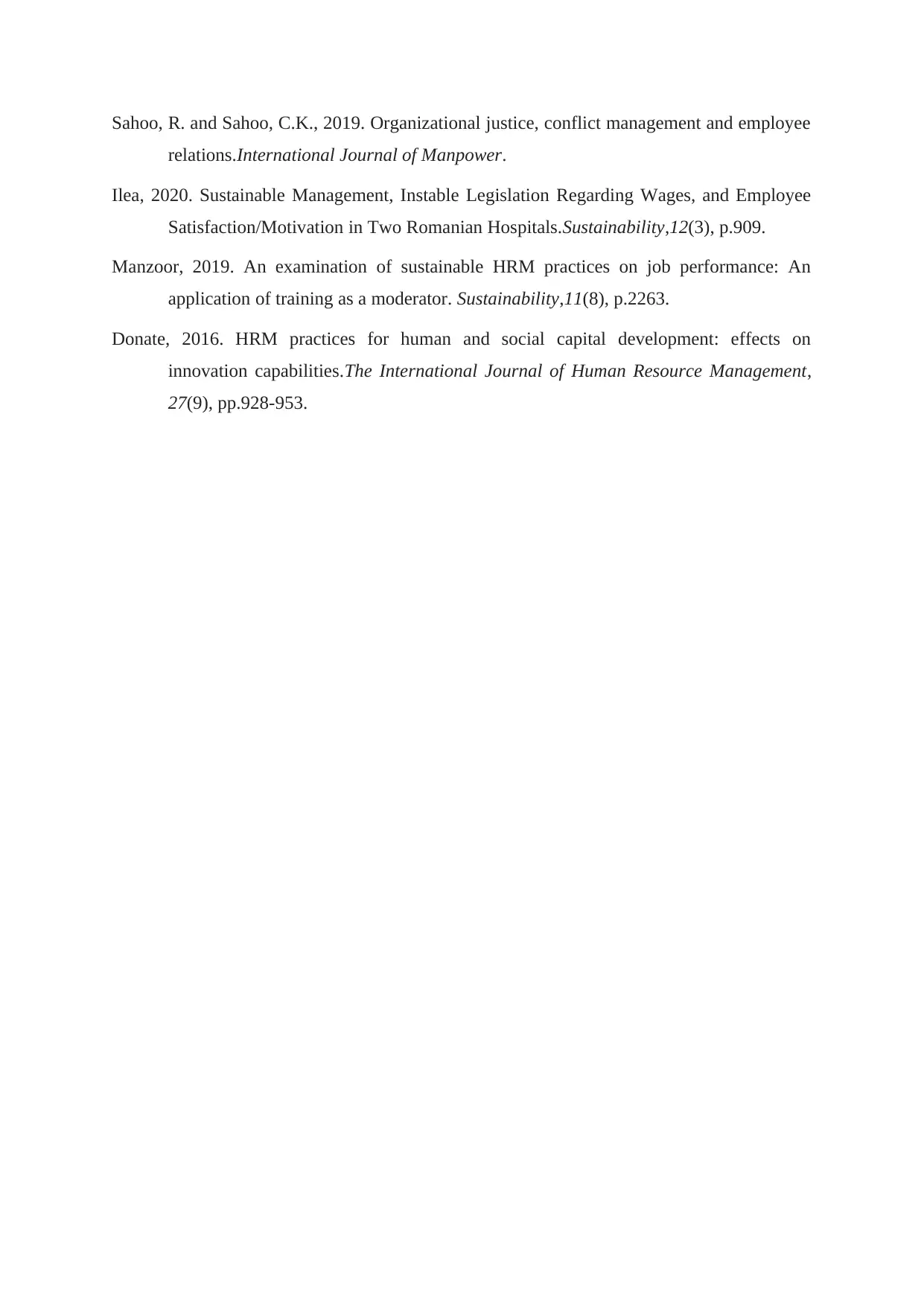
Sahoo, R. and Sahoo, C.K., 2019. Organizational justice, conflict management and employee
relations.International Journal of Manpower.
Ilea, 2020. Sustainable Management, Instable Legislation Regarding Wages, and Employee
Satisfaction/Motivation in Two Romanian Hospitals.Sustainability,12(3), p.909.
Manzoor, 2019. An examination of sustainable HRM practices on job performance: An
application of training as a moderator. Sustainability,11(8), p.2263.
Donate, 2016. HRM practices for human and social capital development: effects on
innovation capabilities.The International Journal of Human Resource Management,
27(9), pp.928-953.
relations.International Journal of Manpower.
Ilea, 2020. Sustainable Management, Instable Legislation Regarding Wages, and Employee
Satisfaction/Motivation in Two Romanian Hospitals.Sustainability,12(3), p.909.
Manzoor, 2019. An examination of sustainable HRM practices on job performance: An
application of training as a moderator. Sustainability,11(8), p.2263.
Donate, 2016. HRM practices for human and social capital development: effects on
innovation capabilities.The International Journal of Human Resource Management,
27(9), pp.928-953.

1 out of 16
Related Documents
Your All-in-One AI-Powered Toolkit for Academic Success.
+13062052269
info@desklib.com
Available 24*7 on WhatsApp / Email
![[object Object]](/_next/static/media/star-bottom.7253800d.svg)
Unlock your academic potential
© 2024 | Zucol Services PVT LTD | All rights reserved.





